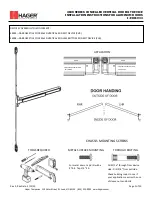
Setup Parameters
5 - 4
Modified: 9/17/08
MedWeld 4000 Operator’s Guide
M-032116 Programs #T03300, #T02300 and #T02400
•
If the weld schedule contains the function VERIFY TIPS
DOWN EVERY nn CYC nn TIMES, and the control performs
the maximum number of test fires without reaching the desired
current value (in the Tips Down Verified Current: nnnn setup
parameter), it generates a TIPS NOT TOUCHING fault. (Refer
to “Dynamic Squeeze Features” on page 7-6.)
SLOW CYLINDER FAULT: (
T03300 only
)(FAULT) (ALERT)
This fault is generated when the control executes the function
SLOW CYLINDER TEST EVERY nn CYC. nn TIMES, and it
detects that primary current has never reached the value
programmed in the Tips Down Verified Current: setup parameter.
(The control repeats the test fire the number of tries programmed in
this function.) Refer to “Dynamic Squeeze Features” on page 7-6.
INITIAL P.F. OUT OF RANGE: (
T03300
)(FAULT) (ALERT)
This fault is generated when the test fire function (#39) appears in a
weld schedule before the function INITIAL PF LIMIT: HI=nn%
LOW=nn%.
If the power factor (indicating secondary resistance) detected
during the test fire is not within the range specified in this function,
this condition is generated.
POWER FACTOR LIMIT: (
T03300 only
)(FAULT) (ALERT)
This condition is generated when the power factor detected while
executing a weld schedule does not fall within the range defined by
the High and Low Power Factor Limit setup parameters.
NOTE:
Function #96 permits overriding the setup parameter for power factor
limits.
VOLTAGE COMPENSATION LIMIT:
(
T03300 only
)
(FAULT) (ALERT)
This fault indicates that the %I firing mode could not fully
compensate for a large swing in line voltage. (The processor can
provide weld current in a range from 20% to 99%I. However, AVC
faults may occur if the programmed range is at or near these limits.)
INSUFFICIENT LINE VOLTAGE:
(
T03300 only
) (FAULT)
(ALERT)
This fault indicates that the weld initiate was removed or time
expired while the control waited for the programmed line voltage
(in Function #72 or #73).
















































